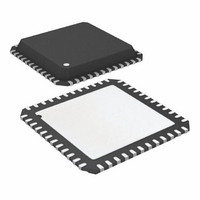ATA6613P-PLQW Atmel, ATA6613P-PLQW Datasheet - Page 8

ATA6613P-PLQW
Manufacturer Part Number
ATA6613P-PLQW
Description
MCU W/LIN TXRX REG WTCHDG 48-QFN
Manufacturer
Atmel
Series
AVR® ATA66 LIN-SBCr
Datasheet
1.ATA6612-EK.pdf
(364 pages)
Specifications of ATA6613P-PLQW
Core Processor
AVR
Core Size
8-Bit
Speed
16MHz
Connectivity
I²C, LIN, SPI, UART/USART
Peripherals
Brown-out Detect/Reset, POR, PWM, WDT
Number Of I /o
23
Program Memory Size
16KB (16K x 8)
Program Memory Type
FLASH
Eeprom Size
512 x 8
Ram Size
1K x 8
Voltage - Supply (vcc/vdd)
2.7 V ~ 5.5 V
Data Converters
A/D 8x10b
Oscillator Type
Internal
Operating Temperature
-40°C ~ 125°C
Package / Case
48-QFN Exposed Pad
Processor Series
ATA6x
Core
AVR8
Data Bus Width
8 bit
Data Ram Size
1 KB
Interface Type
I2C, SPI, USART
Maximum Clock Frequency
16 MHz
Number Of Programmable I/os
23
Number Of Timers
3
Maximum Operating Temperature
+ 125 C
Mounting Style
SMD/SMT
Minimum Operating Temperature
- 40 C
On-chip Adc
10 bit, 8 Channel
Lead Free Status / RoHS Status
Lead free / RoHS Compliant
Available stocks
Company
Part Number
Manufacturer
Quantity
Price
Company:
Part Number:
ATA6613P-PLQW
Manufacturer:
ATMEL
Quantity:
5 000
Part Number:
ATA6613P-PLQW
Manufacturer:
ATMEL/爱特梅尔
Quantity:
20 000
- Current page: 8 of 364
- Download datasheet (7Mb)
3.3.7
3.3.8
3.3.9
3.3.10
3.3.11
3.3.12
3.3.13
8
Atmel ATA6612/ATA6613
Input/Output Pin (TXD)
TXD Dominant Time-out Function
Output Pin (RXD)
Enable Input Pin (EN)
Wake Input Pin (WAKE)
Mode Input Pin (MODE)
TM Input Pin
In Normal Mode the TXD pin is the microcontroller interface used to control the state of the LIN
output. TXD must be pulled to ground in order to have a low LIN-bus. If TXD is high or uncon-
nected (internal pull-up resistor), the LIN output transistor is turned off, and the bus is in
recessive state. During Fail-safe Mode, this pin is used as output. It is current-limited to <
8 mA. and is latched to low if the last wake-up event was from pin WAKE or KL_15.
The TXD input has an internal pull-up resistor. An internal timer prevents the bus line from
being driven permanently in dominant state. If TXD is forced to low for longer than t
the LIN-bus driver is switched to recessive state.
To reactivate the LIN bus driver, switch TXD to high (> 10µs).
The Output pin reports the state of the LIN-bus to the microcontroller. LIN high (recessive
state) is reported by a high level at RXD; LIN low (dominant state) is reported by a low level at
RXD. The output has an internal pull-up resistor with typically 5k to VCC. The AC character-
istics can be defined with an external load capacitor of 20pF.
The output is short-circuit protected. RXD is switched off in Unpowered Mode (i.e., V
The Enable Input pin controls the operation mode of the device. If EN is high, the circuit is in
Normal Mode, with transmission paths from TXD to LIN and from LIN to RXD both active. The
VCC voltage regulator operates with 5V/50 mA output capability.
If EN is switched to low while TXD is still high, the device is forced to Silent Mode. No data
transmission is then possible, and the current consumption is reduced to I
VCC regulator has its full functionality.
If EN is switched to low while TXD is low, the device is forced to Sleep Mode. No data trans-
mission is possible, and the voltage regulator is switched off.
The Wake Input pin is a high-voltage input used to wake up the device from Sleep Mode or
Silent Mode. It is usually connected to an external switch in the application to generate a local
wake-up. A pull-up current source, typically 10µA, is implemented.
If a local wake-up is not needed for the application, connect the Wake pin directly to the VS
pin.
Connect the MODE pin directly or via an external resistor to GND for normal watchdog opera-
tion. To debug the software of the connected microcontroller, connect the MODE pin to VCC
and the watchdog is switched off.
The TM pin is used for final production measurements at Atmel. In normal application, it has to
be always connected to GND.
VS
typ. 57µA. The
9111H–AUTO–01/11
DOM
S
= 0V).
> 6ms,
Related parts for ATA6613P-PLQW
Image
Part Number
Description
Manufacturer
Datasheet
Request
R

Part Number:
Description:
MCU W/LIN TXRX REG WTCHDG 48-QFN
Manufacturer:
Atmel
Datasheet:

Part Number:
Description:
Ata6613
Manufacturer:
ATMEL Corporation
Datasheet:

Part Number:
Description:
BOARD DEMO LIN-MCM FOR ATA6613
Manufacturer:
Atmel
Datasheet:

Part Number:
Description:
DEV KIT FOR AVR/AVR32
Manufacturer:
Atmel
Datasheet:

Part Number:
Description:
INTERVAL AND WIPE/WASH WIPER CONTROL IC WITH DELAY
Manufacturer:
ATMEL Corporation
Datasheet:

Part Number:
Description:
Low-Voltage Voice-Switched IC for Hands-Free Operation
Manufacturer:
ATMEL Corporation
Datasheet:

Part Number:
Description:
MONOLITHIC INTEGRATED FEATUREPHONE CIRCUIT
Manufacturer:
ATMEL Corporation
Datasheet:

Part Number:
Description:
AM-FM Receiver IC U4255BM-M
Manufacturer:
ATMEL Corporation
Datasheet:

Part Number:
Description:
Monolithic Integrated Feature Phone Circuit
Manufacturer:
ATMEL Corporation
Datasheet:

Part Number:
Description:
Multistandard Video-IF and Quasi Parallel Sound Processing
Manufacturer:
ATMEL Corporation
Datasheet:

Part Number:
Description:
High-performance EE PLD
Manufacturer:
ATMEL Corporation
Datasheet:

Part Number:
Description:
8-bit Flash Microcontroller
Manufacturer:
ATMEL Corporation
Datasheet:











